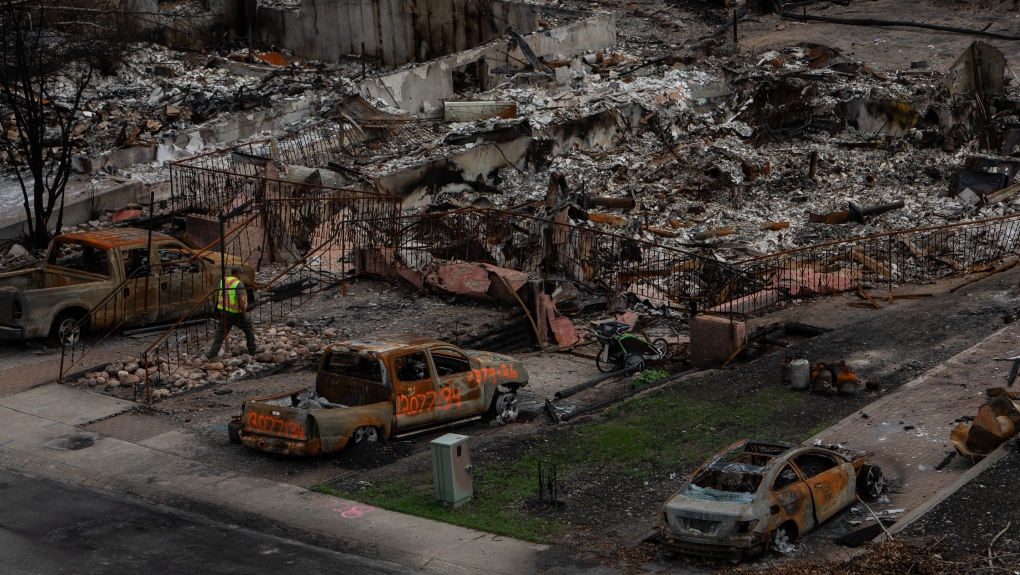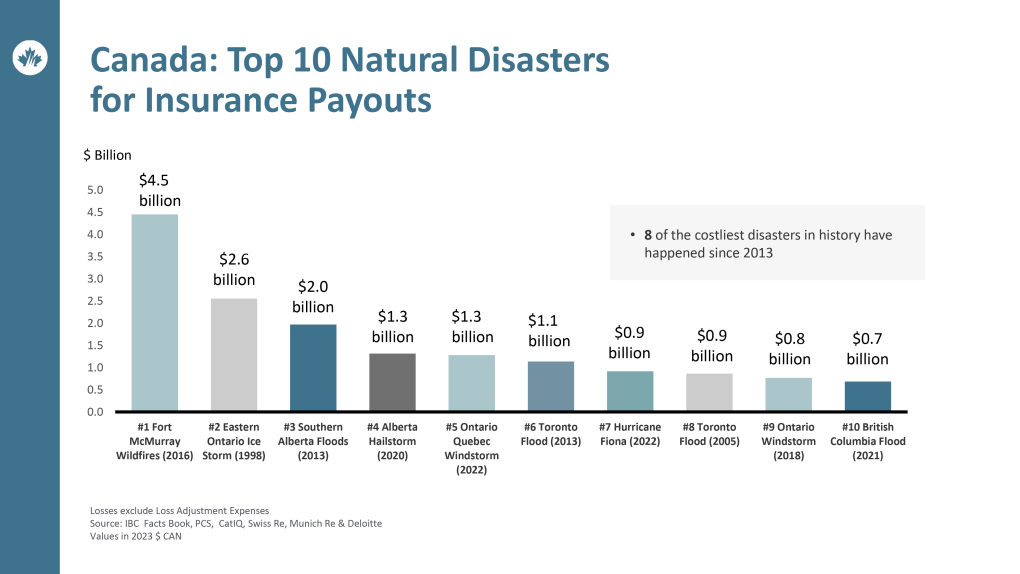Jasper wildfire ranks in top 10 of insurance payouts from natural disasters in Canada
 A worker walks in a devastated neighbourhood in west Jasper, Alberta on Monday August 19, 2024. Wildfire caused evacuations and widespread damage in the National Park and Jasper townsite. THE CANADIAN PRESS/Amber Bracken
A worker walks in a devastated neighbourhood in west Jasper, Alberta on Monday August 19, 2024. Wildfire caused evacuations and widespread damage in the National Park and Jasper townsite. THE CANADIAN PRESS/Amber Bracken
An early estimate by the Insurance Bureau of Canada has placed the wildfire that burned about 30 per cent of the Jasper townsite at the end of July as the ninth highest insurance payout from a natural disaster in Canadian history and the costliest event in all of national park history.
The insured damages – consisting only of those covered by the IBC, like homes, businesses and vehicles – total $880 million, IBC's Rob de Pruis told the municipal council Tuesday morning.
The Jasper wildfire landed behind Toronto's 2005 flood, which caused $900 million in insurance payouts, and ahead of Ontario's 2018 wind storm, which caused $800 million in insurance payouts.
de Pruis said the wildfire's ranking could change by the end of the year as insurance payouts from other recent natural disasters are totalled, like the hail storm in Calgary or floods in Ontario and Montreal.
In Jasper, 2,500 claims have been made. Comparatively, the Calgary storm has so far spurred 35,000 claims, the Ontario flood 25,000 and Montreal flood 70,000.
IBC also noted an upward trend in catastrophic losses since the 1980s, with the eight costliest disasters having happened since 2013.
Goal is to finish debris removal by end of year
de Pruis submitted the data to Jasper's council as part of an update on the cleanup work underway in destroyed neighbourhoods. On Tuesday, household appliances were being degassed and removed.
He said his teams hope to have all the debris removed by the end of November.
"That's a bit ambitious; we're hoping that we're going to have all of the debris cleared by the end of this calendar year," de Pruis said.
"But we understand everyone's desire for an expedited and effective process, so we will get going as soon as we have the authorizations and clearance and we're going to start see that hauling done."
Update on utility services, temporary housing
Council also received an update from Michael Fark, the director of recovery from the joint recovery coordination centre, which has replaced the unified command centre that led the wildfire response.
According to him, 84 per cent of eligible homes have been re-hooked up to gas and "pretty much everywhere" has been re-electrified.
He also reported the results of a survey about temporary housing needs among displaced residents: 390 people have completed an application for temporary housing, about a quarter of which are essential workers who will be prioritized.
Fark said the recovery centre is considering putting up those essential workers for the next three months in the firefighter camp currently based in Hinton after it has been moved to the Whistlers Campground parking lot.
As for interim housing for those whose homes were damaged and who will be displaced longer, Fark said the recovery centre is considering bringing family friendly modular housing into or immediately adjacent to the municipality. The centre is also seeing what capacity is available in hotels.
Council approves extra fire staff
Also on Tuesday, council unanimously approved the fire department hiring a second captain on a two-year term and 10 short-term firefighters on contracts.
Director of legislative and protective services Christine Nadon and fire chief Mathew Conte told council additional staff is needed to keep Jasper stable, from keeping the highway open to ensuring resources were available to respond to a fire call in town.
The captain is needed to supervise more firefighting staff and, longer term, to take on inspection work once Jasper residents and businesses start to rebuild.
Until the town is back on its feet, "we are not in a position to maintain our level of service ourselves," Nadon said, noting firefighters were dealing with much of the same trauma as residents.
The officials believe the majority of the costs – 90 per cent, and possibly more – will be eligible under Alberta's Disaster Recovery Program.
However, the decision could result in a tax increase to those whose property was not ruined, Mayor Richard Ireland said.
The third of the town that was burned to the ground represents a loss of assessment of about $282 million, but not a third of Jasper's overall assessment of $2.3 billion, according to Ireland.
"And so whatever I think, a relatively small, increase in tax burden might result from this – after we deal with the division of the 10 per cent and the opportunity to apply even for recovery of that – I think it's fair to say the 70 per cent of the properties that remain do so because of the valour and the bravery of a volunteer fire department which has been decimated.
"This is the only way we can move forward. We cannot have residents back in town (and) we cannot have visitors come back to town without a functioning fire department. This is where we have got to because of the sacrifices of our own volunteers."
CTVNews.ca Top Stories

Canadian team told Trump's tariffs unavoidable right now, but solutions on the table in surprise Mar-a-Lago meeting
During a surprise dinner at Mar-a-Lago, representatives of the federal government were told U.S. tariffs from the incoming Donald Trump administration cannot be avoided in the immediate term, two government sources tell CTV News.
Pedestrian killed by Via Rail train near Kingston, Ont.
Regular rail traffic has resumed with severe delays.
Muskoka reacts to major snowfall, hundreds stuck on Highway 11
From road closures, power outages, weather declarations and nonstop shovelling, Muskoka residents were faced with nearly a metre of persistent snowfall on Saturday.
Saskatoon priest accused of sexual assault says he meant to encourage young girl with hug and kiss
A Saskatoon priest accused of sexual assault says he meant to encourage and reassure a young girl when he hugged and kissed during his testimony at Saskatoon Provincial Court Friday.
Trump threatens 100% tariff on the BRIC bloc of nations if they act to undermine U.S. dollar
U.S. president-elect Donald Trump on Saturday threatened 100 per cent tariffs against a bloc of nine nations if they act to undermine the U.S. dollar.
Toronto man accused of posing as surgeon, giving four women injections
A 29-year-old Toronto man has been charged after allegedly posing as a surgeon and providing cosmetic procedures on several women.
Bob Bryar, drummer for rock band My Chemical Romance, dead at 44
Bob Bryar, former drummer for the band My Chemical Romance, has died. He was reportedly 44.
'Disappointing': Toronto speed camera cut down less than 24 hours after being reinstalled
A Toronto speed camera notorious for issuing tens of thousands of tickets to drivers has been cut down again less than 24 hours after it was reinstalled.
W5 Investigates 'I never took part in beheadings': Canadian ISIS sniper has warning about future of terror group
An admitted Canadian ISIS sniper held in one of northeast Syria’s highest-security prisons has issued a stark warning about the potential resurgence of the terror group.


































